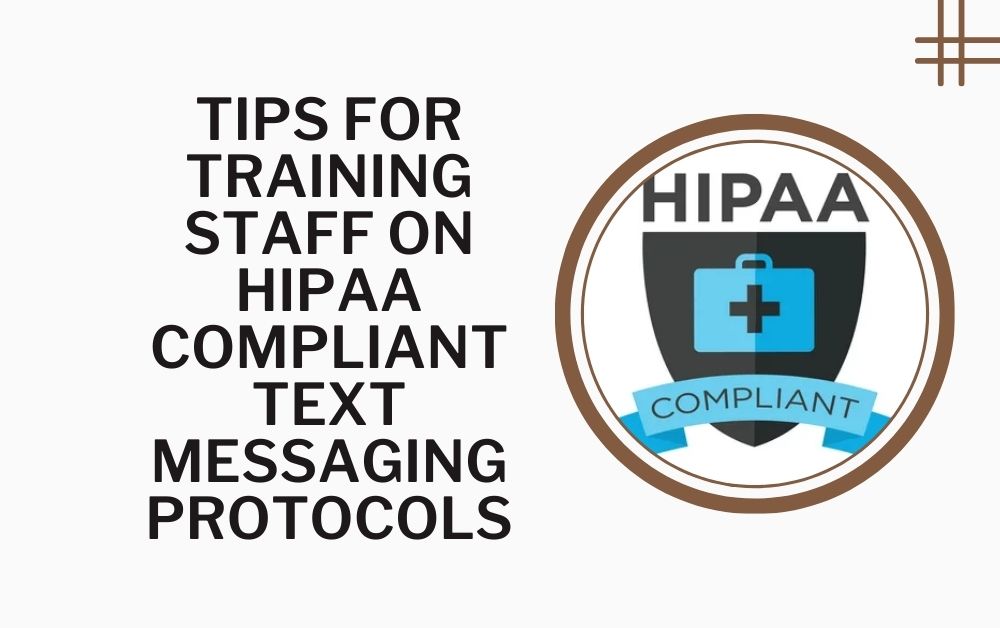Tips for Training Staff on HIPAA Compliant Text Messaging Protocols
Patient information protection is not only a top priority in the healthcare industry, but it’s also required by law. HIPAA, the Health Insurance Portability and Accountability Act, establishes the guidelines for protecting sensitive patient data. To protect patient information, text messaging—a popular means of communication in healthcare settings—must abide by HIPAA laws. It’s critical to train your employees on HIPAA-compliant text messaging procedures. This article will walk you through practical training techniques to support your employees in using text messaging in a responsible and compliant manner.
Understanding HIPAA and Its Importance in Text Messaging
HIPAA compliance can seem complex, but at its core, it’s about protecting patient privacy. When staff understand why they must follow certain protocols, they are more likely to take them seriously. Begin your training sessions by explaining what HIPAA is and why it is critical. Discuss the potential consequences of HIPAA violations, which can include legal penalties for the individual and the organization.
Highlight the importance of using only approved, secure text messaging apps designed to protect patient information. These apps often include features like encryption, secure login processes, and the ability to audit message histories. Make sure your staff understands that using regular SMS text messaging or other unsecured apps is not compliant with HIPAA.
Note – Ready to elevate the security and compliance of your patient communications? Discover the best HIPAA compliant text messaging app today and ensure your practice meets all HIPAA standards. Click here to learn more and get started with a solution that protects both you and your patients.
Training Strategies for Effective Compliance
Effective training involves more than just telling staff what to do; it requires engaging them in the learning process. Here are some strategies to make your training effective:
- Interactive Sessions: Use interactive training sessions that involve real-life scenarios. This could include role-playing exercises where staff must decide how to respond to a message request involving patient information.
- Regular Updates: HIPAA regulations and technology are continually evolving. Hold regular training sessions to update staff on any changes in compliance requirements or secure messaging technologies.
- Assessment and Feedback: After training, assess your staff’s understanding through quizzes or practical tests. Provide feedback based on their performance to help them improve.
By incorporating these strategies, you can ensure your staff is not only aware of the regulations but also understands how to apply them in their daily communications.
Implementing Secure Text Messaging Systems
Choosing the right HIPAA compliant text messaging app is crucial for compliance. However, implementing these systems in a way that all staff members can use them effectively involves several important steps:
- Selection of the Right Tool: Select an app that is easy to use and integrates well with other systems in use at your facility. It should have a strong reputation for security and reliability.
- Comprehensive Training: Provide comprehensive training on how to use the new app. Make sure every staff member understands how to send, receive, and manage messages securely.
- Ongoing Support: Offer ongoing support to handle any questions or issues that arise. This could be in the form of an IT helpdesk or designated staff who can provide immediate help.
Implementing a secure system with thorough training ensures that your staff can communicate efficiently without compromising patient privacy.
Monitoring and Enforcing Compliance
After training your staff and implementing a secure text messaging system, the next step is to monitor compliance and enforce the rules. This includes:
- Regular Audits: Conduct regular audits of text message usage to ensure compliance with HIPAA. This helps identify any breaches or misuse of the system.
- Enforcement Policies: Develop clear policies for what happens if staff do not follow HIPAA protocols. This may include disciplinary actions or additional training.
- Encourage Reporting: Encourage staff to report any suspicious or non-compliant activities they notice. An open environment where staff feels comfortable reporting issues is crucial for maintaining compliance.
Monitoring and enforcement help maintain the integrity of your patient data protection efforts and ensure that the training your staff received is put into practice.
Conclusion
Training your staff on HIPAA compliant text messaging is not just about following the law; it’s about protecting your patients’ privacy and maintaining the trust they place in your healthcare facility. By understanding the importance of compliance, employing effective training strategies, implementing secure systems, and monitoring usage, you can ensure that your staff communicates safely and legally. This not only protects your patients but also helps maintain the credibility and integrity of your healthcare practice.
For more insightful articles related to this topic, feel free to visit allguestblog.com






